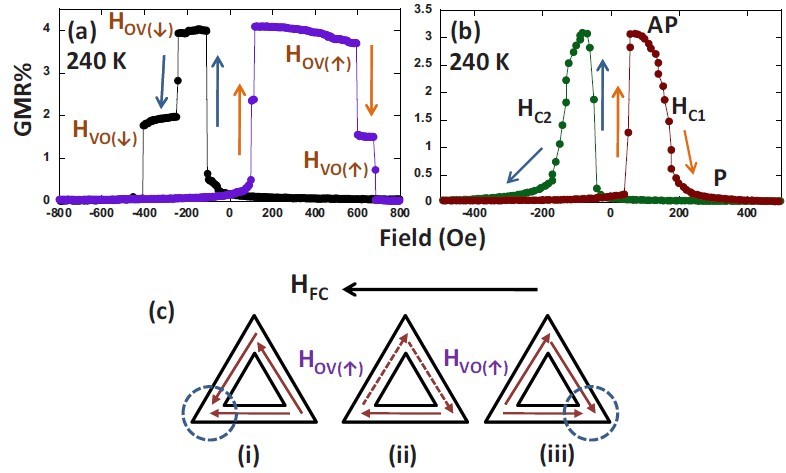Spin Dependent Transport in Nanomagnets  One of the main challenges in nanomagnetism research is the detection of spin state at nanoscale. It is extremely difficult to measure the magnetization of single nanomagnets because the output signal is beyond the detection limit of most conventional magnetometers. Magnetoresistance measurements have been widely used to investigate the reversal mechanism and map the magnetization states in individual nanostructures (nanoelements). This technique, however, is normally implemented by fabricating the contact probes directly on the nanostructures. Consequently, the magnetoresistance response is strongly dependent on the contact configuration. This approach may result in a detrimental shunting effect. Any probing technique that maps the spin states of the entire ring structure without any dependence on the electrical contact configuration is desirable. One of the main challenges in nanomagnetism research is the detection of spin state at nanoscale. It is extremely difficult to measure the magnetization of single nanomagnets because the output signal is beyond the detection limit of most conventional magnetometers. Magnetoresistance measurements have been widely used to investigate the reversal mechanism and map the magnetization states in individual nanostructures (nanoelements). This technique, however, is normally implemented by fabricating the contact probes directly on the nanostructures. Consequently, the magnetoresistance response is strongly dependent on the contact configuration. This approach may result in a detrimental shunting effect. Any probing technique that maps the spin states of the entire ring structure without any dependence on the electrical contact configuration is desirable.
Recently, we developed a novel synchronous transport measurement technique for probing the magnetic configurations in ferromagnetic rings electrically without placing the electrical contact leads directly on the nanostructures. This was achieved by fabricating the contact pads on magnetic nanowires attached to the nanostructures. This involves the use of strong dependence of the coercive field on the lateral size to create a new magnetic system whose spin dependent transport properties uniquely depend on the combination of spin orientations of each part of the device. We have:
- Demonstrated using this technique, coherent rotational switching characteristics of a single chain of nanodots.
- Studied the reversal mechanism in complex castellated magnetic structures.
- Systematically mapped the magnetic configurations in pseudo spin valve rectangular and elliptical rings of width in the range from 60 to 300 nm.
- Shown that the stability of the vortex state in the rings can be systematically controlled by varying the orientation and position of the individual magnetic elements relative to the ring structure.
- Investigated the field orientation dependent vortex formation in individual multilayer rings. We observed that the magnetization states in the ring are highly sensitive to the direction of the applied field due to strong configurational anisotropy of the geometry. Therefore, the formation of vortex state is dependent on the angle between the edges of the triangle and the applied field orientation.

Further readings:
- S. Jain and A. O. Adeyeye , Applied Physics Letters 94, 062510 (2009)
- S. Jain, and A. O. Adeyeye, Applied Physics Letters 92, 202506 (2008)
- S. Jain and A. O. Adeyeye, Euro Physics Letters 84, 17002 (2008)
- S. Jain, D. Tripathy, and A. O. Adeyeye Journal of Applied Physics 105, 123916 (2009)
- A. O. Adeyeye and M. E. Welland, Applied Physics Letters, Vol. 80(13) 2344, (2002)
- A. O. Adeyeye and R. L. White, Journal Of Applied Physics, Vol. 95, 2025-2028, February (2004)
|

